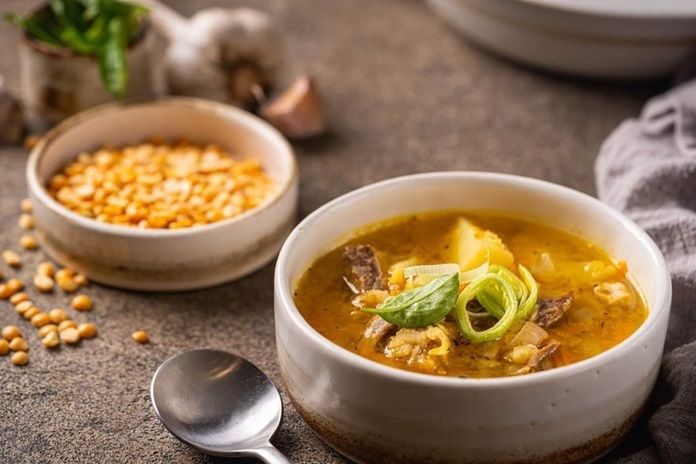National Split Pea Soup Week occurs each year as the leaves turn golden and the weather gets cooler. This classic soup is a beloved tradition that brings us into our warm and cozy kitchens. This is celebrated in the middle of autumn which honors a dish that is as rich in history as it is in taste. Similarly, with its colorful vegetables, hearty meats, and fresh peas, split pea soup delights the senses and temps anyone nearby to take a bite. From November 10-16, celebrate National Split Pea Soup Week by savoring this comforting dish with its inviting smell and cozy warmth.
History of National Split Pea Soup Week
The beginnings of National Split Pea Soup Weel are as comforting and rich as the soup itself. It started celebrating in 1969 and this yearly celebration has been warming hearts and kitchens for decades.
However, the tradition of pea soup stretches back much further, spanning centuries and continents. The earliest records date back to 500 B.C., when pea soup was a favorite among street vendors in ancient Greek and Roman societies.
Moreover, it even earned a mention in Aristophanes’ comedic play, The Birds. The enduring popularity of this hearty soup speaks to its versatility and widespread appeal across cultures and time.
In the 1700s, pea soup became popular in Northern Europe, especially in the Nordic countries like Denmark and Norway. It was a staple for enduring the long, harsh winters due to its simplicity. The use of stored ingredients like dried peas and preserved meats makes it perfect for the colder months.

During this period, the soup evolved as each region added its unique touch, adapting the recipe to fit local tastes and available ingredients.
Split peas are enjoyed across the globe, from the Indian subcontinent to the Middle East and the Americas. It’s a soup with true worldwide appeal.
Timeline of National Split Pea Soup Week
| 1867 (Instant pea soup invented) | One of the very first instant products was a pea soup product, invented by Johann Heinrich Grüneberg in Germany. |
| 1765 (Pea soup gets a nursery rhyme) | Pease porridge hot, Pease porridge cold, Pease porridge in the pot, Nine days old. |
| 500 B.C. (Pea soup is sold for the first time) | Greek and Roman vendors used to sell it in the streets of Athens. |
| 1700 B.C. (Pea soup invented) | There is speculation that pea soup was served in Denmark as early as the Bronze Age when dried peas and cabbage became popular for the long winters there. |
5 Interesting Facts About Pea Soup
- It Goes Back to the Greeks: Split pea soup was so popular that it even found its way into literature, being mentioned in The Birds, a play by Aristophanes, a famous Athenian playwright.
- Pea Soup Has a “Saying”: In Francophone Canada, pea soup is often served with johnny cake, leading to the saying, “pea soup and johnny cake makes a Frenchman’s belly ache.”
- Pea Soup Was Made for Winter Sports Enthusiasts: In the Netherlands, small food stalls called “Koek en zopie” were set up along frozen canals and lakes to serve ice skaters during winter, with pea soup being a popular savory snack.
- Pea Soup Helps Weathermen: The term “pea-souper” refers to the thick, greenish fog that once blanketed London and other UK cities, resembling the dense consistency of pea soup.
- Pea Soup Was Used as a Weapon: Swedish King Eric XIV (1533-1577) reportedly died after eating pea soup laced with arsenic—a reminder that the soup’s history isn’t just savory, but also a bit sinister!
Conclusion
National Split Pea Soup Week not only celebrates a comforting dish but also honors a rich history that spans centuries and continents. From its ancient beginnings in Greek and Roman societies to its evolution in Northern Europe and beyond, split pea soup has remained a beloved staple across cultures.
Its hearty, nourishing nature makes it perfect for cold weather, symbolizing warmth and togetherness. As you enjoy a bowl during National Split Pea Soup Week, remember that you’re partaking in a tradition that has warmed hearts and kitchens for generations. So grab a spoon, savor each bite, and keep the legacy of this timeless soup alive!
Frequently Ask Question
When did National Split Pea Soup Week begin?
National Split Pea Soup Week started in 1969. Since then, it has become a cherished tradition, celebrating the classic soup and its cultural significance.
Why is split pea soup particularly suited for colder weather?
Split pea soup is ideal for cold weather because it uses stored ingredients like dried peas and preserved meats, making it a hearty and warming dish for the colder months. Its rich and filling nature has historically made it a staple during long winters.
Why is it called split pea soup?
Split pea soup gets its name from the main ingredient: dried split peas. These peas are called “split” because they are peeled, dried, and then split in half. This process makes them easier to cook and gives the soup its distinctive texture and flavor.
What is the history of split pea soup?
Split pea soup has a long history dating back to ancient Greece and Rome around 500 B.C., where it was sold by street vendors. It became popular in Northern Europe in the 1700s, particularly in Nordic countries, due to its suitability for harsh winters. The soup has evolved across various cultures, adapting to local tastes and ingredients.
How long does split pea soup last?
Split pea soup can last about a week in the refrigerator or up to three months in the freezer. To freeze, let the soup cool completely, then transfer it to freezer containers or bags. When you’re ready to eat it, thaw the soup overnight in the refrigerator, or gently reheat it on the stove over low heat.
You may also like to read, National Eggnog Day – December 24, 2024
